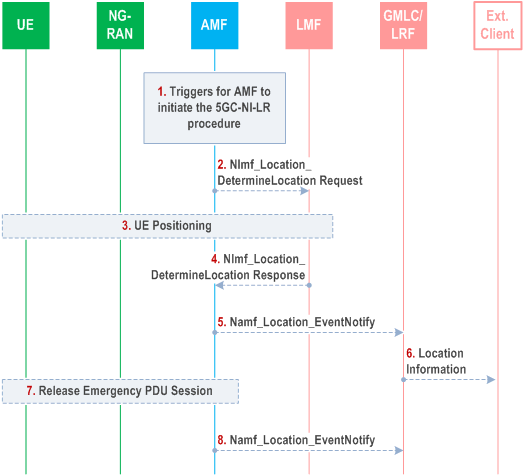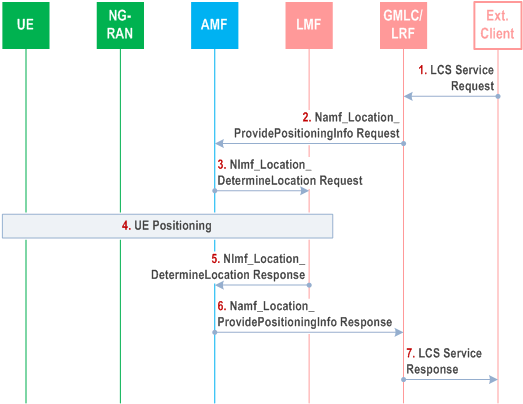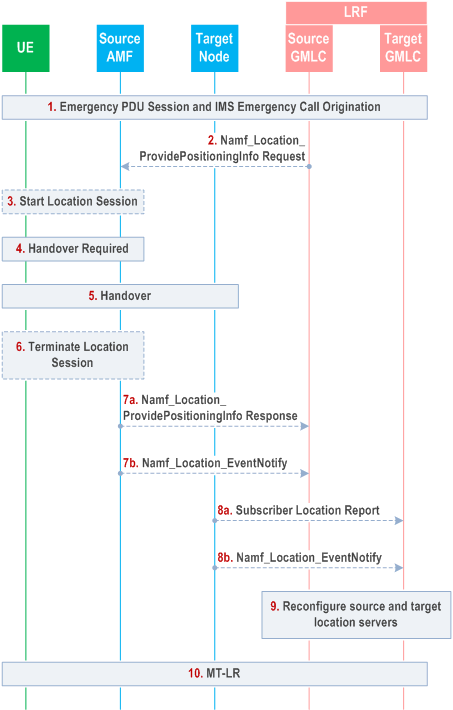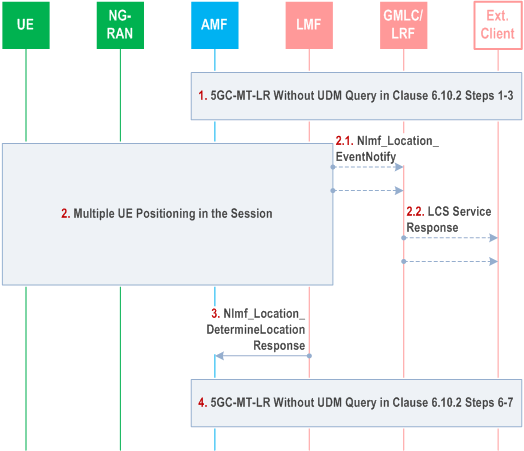Content for TS 23.273 Word version: 18.6.0
1…
4…
4.2…
4.2a…
4.3…
5…
5.5…
6…
6.1.2
6.1.3
6.1.4
6.2
6.3…
6.3.2…
6.4
6.5…
6.7…
6.7.3
6.7.4
6.7.5
6.8
6.9…
6.10…
6.11…
6.12…
6.13…
6.14…
6.15…
6.16…
6.17…
6.18…
6.19…
6.19.3…
6.20…
6.20.4…
6.21…
7…
8…
A…
B…
C…
6.10 Procedures dedicated to Support Regulatory services
6.10.1 5GC-NI-LR Procedure
6.10.2 5GC-MT-LR Procedure without UDM Query
6.10.3 Location continuity for Handover of an Emergency session from NG-RAN
6.10.4 5GC-MT-LR multiple location procedure without UDM Query
...
...
6.10 Procedures dedicated to Support Regulatory services p. 93
6.10.1 5GC-NI-LR Procedure p. 93
Figure 6.10.1-1 shows a Network Induced Location Request (NI-LR) procedure for a UE in the case where the UE initiates an emergency session or other session using NG-RAN. The procedure assumes that the serving AMF is aware of the regulatory service associated with the session (e.g. emergency session initiation - e.g. due to supporting an Emergency Registration procedure or assisting in establishing an emergency PDU Session). The procedure can also be used to verify UE location for NR satellite access.

Step 1.
A trigger for AMF to initiate the 5GC-NI-LR procedure happens, e.g. the UE registers to the 5GC for emergency services or requests the establishment of a PDU Session related to an applicable regulatory service (e.g. emergency session initiation) or the AMF decides to verify UE location via LCS procedure for a UE registered for NR satellite access.
Step 2.
For verifying UE location via LCS service for NR satellite access this step is mandatory, for other triggers this step is optional. The AMF selects an LMF based on NRF query or configuration in AMF and invokes the Nlmf_Location_DetermineLocation service operation towards the LMF to request the current location of the UE. The service operation includes a LCS Correlation identifier, the serving cell identity of the Primary Cell in the Master RAN node and the Primary Cell in the Secondary RAN node when available based on Dual Connectivity scenarios, and an indication of a location request from a regulatory services client (e.g. emergency services) and may include an indication if UE supports LPP, the required QoS and Supported GAD shapes, the UE Positioning Capability if available. When AMF needs to know the geographical area of the UE to check whether the PLMN is allowed to operate in the area, an indication of this is included. When AMF needs to verify the location of the UE when a UE registers via NR satellite access, the AMF includes in indication in the request to the LMF that the request is for UE location verification. If any of the procedures in clause 6.11.1 or 6.11.2 are used the service operation includes the AMF identity. Optionally, the AMF may also request UE related analytics containing UE location information (e.g., UE mobility analytics) from NWDAF to assist with UE location verification for NR satellite access as described in clause 6.21.2.
Step 3.
[Conditional] If step 2 occurs, the LMF performs one or more of the positioning procedures described in clause 6.11.1, 6.11.2 and 6.11.3. If the AMF included an indication at step 2, the LMF maps the UE location to a geographical area where a PLMN is or is not allowed to operate.
Step 4.
[Conditional] If step 3 occurs, the LMF returns the Nlmf_Location_DetermineLocation Response towards the AMF to return the current location of the UE. The service operation includes the LCS Correlation identifier, the location estimate, its age and accuracy and may include information about the positioning method and the timestamp of the location estimate. The service operation also includes the UE Positioning Capability if the UE Positioning Capability is received in step 3 including an indication that the capabilities are non-variable and not received from AMF in step 2. When UE geographical area determination for location verification is indicated at step 2, the service operation also returns the geographical area where a PLMN is or is not allowed to operate determined at step 3.
Step 5.
[Conditional] For emergency services, the AMF selects an GMLC based on NRF query or configuration in AMF. The information regarding the endpoint in the GMLC to deliver the event notification, is obtained from the NRF as specified in clause 7.1.2 of TS 23.501 or from local configuration in the AMF. AMF invokes the Namf_Location_EventNotify service operation towards the selected GMLC to notify the GMLC of an emergency session initiation. The service operation includes the SUPI or the PEI, and the GPSI if available, the identity of the AMF, an indication of an emergency session and any location obtained in step 3.
Step 6.
[Conditional] For emergency services, the GMLC forwards the location to an external emergency services client or may wait for a request for the location from the external emergency services client (not shown in Figure 6.10.1-1) before forwarding the location.
Step 7.
[Conditional] For emergency services, the emergency services session and emergency PDU Session are released.
Step 8.
[Conditional] For emergency services, the AMF invokes the Namf_Location_EventNotify service operation towards the GMLC to notify the GMLC that the emergency session was released to enable the GMLC and LRF to release any resources associated with the emergency session.
6.10.2 5GC-MT-LR Procedure without UDM Query p. 95
Figure 6.10.2-1 illustrates a location request for an emergency services session, where an emergency services client (e.g. a Public Safety Answering Point) identifies the target UE and the serving LRF using correlation information that was previously provided to it by the IMS Core. The signalling used to provide the correlation information to the PSAP is defined in TS 23.167. The correlation information may be used by the LRF to retrieve other information previously provided to it by the IMS Core and/or AMF as described for Figure 6.10.1-1. This allows the GMLC associated with the LRF to request a location from the AMF without needing to query the UDM of the target UE for the serving AMF address. This scenario therefore supports location of emergency sessions from roamers and USIM-less and other non-registered UEs, and requires that identifying information for the UE and AMF have been provided to the GMLC/LRF as described in clauses 6.10.1 and 6.10.3.

Step 1.
The external emergency services client (e.g. a PSAP) sends a request to the LRF for a location for the target UE and includes correlation information identifying the target UE. The request may include the required QoS and Supported GAD shapes. The LRF address and the correlation information would have been previously provided to the external client when the emergency session from the UE was established.
Step 2.
The LRF/GMLC determines the AMF by associating the correlation information received from the external client with other information received previously from the AMF as described in step 5 of clause 6.10.1 and step 7 of clause 6.10.3. The GMLC invokes the Namf_Location_ProvidePositioningInfo service operation towards the AMF to request the current location of the UE. The service operation includes the SUPI or the PEI or GPSI and an indication of a location request from an emergency services client and may include the required QoS and Supported GAD shapes. The AMF identifies the target UE using the SUPI or in the case of a USIM-less emergency session, or non-registered USIM emergency session, the PEI.
Step 3.
The AMF selects an LMF based on NRF query or configuration in AMF and invokes the Nlmf_Location_DetermineLocation service operation towards the LMF to request the current location of the UE. The service operation includes a LCS Correlation identifier, the serving cell identity and an indication of a location request from an emergency services client and may include an indication if UE supports LPP, the required QoS and Supported GAD shapes, UE Positioning Capability if available. If any of the procedures in clause 6.11.1 or clause 6.11.2 are used the service operation includes the AMF identity.
Step 4.
The LMF performs one or more of the positioning procedures described in clauses 6.11.1, 6.11.2 and 6.11.3.
Step 5.
The LMF returns the Nlmf_Location_DetermineLocation Response towards the AMF to return the current location of the UE. The service operation includes the location estimate, its age and accuracy and may include information about the positioning method and the timestamp of the location estimate. The service operation also includes the UE Positioning Capability if the UE Positioning Capability is received in step 4 including an indication that the capabilities are non-variable and not received from AMF in step 3.
Step 6.
The AMF returns the Namf_Location_ProvidePositioningInfo Response towards the GMLC/LRF to return the current location of the UE. The service operation includes the LCS Correlation identifier, the location estimate, its age and accuracy and may include information about the positioning method and the timestamp of the location estimate.
Step 7.
The LRF sends the location service response to the external emergency services client.
6.10.3 Location continuity for Handover of an Emergency session from NG-RAN p. 96
Figure 6.10.3-1 shows support for location continuity for handover of an emergency session from NG-RAN on the source side to either NG-RAN or another 3GPP RAN on the target side. The procedure applies when control plane location according to Figures 6.10.1-1 and 6.10.2-1 is used for location of the UE on the source side. The procedure is based on the procedures for location continuity currently defined in clause 9.4.5.4 of TS 23.271.

Step 1.
Following the request for an emergency session, the UE establishes a PDU Session for emergency services and an IMS emergency session for NG-RAN access, during which an LRF is assigned in the serving network IMS and a source GMLC may be chosen. The 5GC-NI-LR procedure of Figure 6.10.1-1 is also performed which provides the source AMF identity to the GMLC and LRF and optionally an initial location for the UE.
Step 2.
At some later time, the LRF may need the UE location and requests the source GMLC to invoke the Namf_Location_ProvidePositioningInfo service operation towards the AMF to request the current location of the UE. The service operation includes the SUPI or the PEI, the required QoS and an indication of a location request from an emergency services client.
Step 3.
If step 2 occurs or if support for an NI-LR is required, the source AMF starts a location session to obtain the location of the UE as described in clause 6.10.2 or clause 6.10.1.
Step 4.
The source AMF receives a request to handover the UE to a cell associated with a different target node which may be another AMF for intra-RAN handover or a different type of node (e.g. an MME) for inter-RAN handover (e.g. to E-UTRAN connected to EPC).
Step 5.
The handover procedure is executed as specified in clause 4.9.1.3 of TS 23.502.
Step 6.
Any location session started in step 3 may terminate normally before step 6. If not, the source AMF shall abort the location session once step 5 is complete.
Step 7a.
If steps 2 and 3 has occurred, the source AMF returns the Namf_Location_ProvidePositioningInfo Response towards the GMLC to return any location estimate and the timestamp of the location estimate (if available) obtained for the UE. The service operation includes the target node identity.
Step 7b.
If steps 2 and 7a do not occur, the source AMF may invoke the Namf_Location_EventNotify service operation towards the source GMLC (i.e. the GMLC used in step 1) to indicate the handover. The service operation includes the SUPI or the PEI and the GPSI if available, an event type indicating handover and the identity of the target node.
Step 8a.
For inter-RAN handover (e.g. to E-UTRAN connected to EPC) and if control plane location will be used on the target side, the target node (e.g. MME) may send a Subscriber Location Report to a GMLC on the target side after completion of the handover in step 6. The Subscriber Location Report carries the UE identity (IMSI, MSISDN and/or IMEI), an event type indicating handover and the identity of the target node. The target node may determine the target GMLC from configuration information.
Step 8b.
For intra-RAN handover and if control plane location will be used on the target side, the target AMF may invoke the Namf_Location_EventNotify service operation towards the GMLC to indicate the handover. The service operation includes the SUPI or the PEI and the GPSI if available, an event type indicating handover and the identity of the target node.
Step 9.
Reconfiguration of the LRF and the source and target GMLCs may occur in a manner outside the scope of 3GPP.
Step 10.
If the LRF needs a location estimate for the UE after handover has occurred and if control plane location is used on the target side, the LRF may instigate an MT-LR request via the target Node.
6.10.4 5GC-MT-LR multiple location procedure without UDM Query |R18| p. 98
Figure 6.10.4-1 illustrates an extension procedure of 5GC-MT-LR procedure without UDM Query for the regulatory location service defined in clause 6.10.2.
This procedure is applicable for providing multiple location estimates of the target UE to emergency services client.

Step 1.
Steps 1-3 for 5GC-MT-LR procedure without UDM Query in clause 6.10.2 are performed with the following differences:
Step 2.
- At step 1 in clause 6.10.2 the request from external emergency client (e.g. a PSAP) location services client may include the acceptance of INTERMEDIATE response and maximum response time.
-
At step 2 in clause 6.10.2 Namf_
Location_ service operation invoked by GMLC may include the acceptance of INTERMEDIATE response and maximum response time, GMLC contact address and LIR reference number. The LIR reference number is allocated by GMLC based on predefined rule.ProvidePositioningInfo -
At step 3 in clause 6.10.2 Nlmf_
Location_ service operation invoked by AMF may include the acceptance of INTERMEDIATE response and maximum response time, GMLC contact address, and LIR reference number. AMF can overwrite maximum response time to avoid timeout.DetermineLocation
LMF performs positioning procedures and determines multiple location estimates during the session.
Step 2.1.
This step is executed if INTERMEDIATE response is available. The LMF invokes an Nlmf_Location_EventNotify service operation towards GMLC and provides the INTERMEDIATE location of the UE and timestamp of the location estimate, and LIR reference number, and INTERMEDIATE event type.
Step 2.2.
This step is executed if step 2.1 was executed. The GMLC sends the INTERMEDIATE location of the UE and timestamp of the location estimate to external location services client.
Step 3.
Based on step 5 in clause 6.10.2 the LMF returns the Nlmf_Location_DetermineLocation Response towards the AMF to return the FINAL location of the UE. LMF ensures that FINAL location will be transferred towards AMF within the maximum response time.
Step 4.
Steps 6-7 for 5GC-MT-LR procedure without UDM Query in clause 6.10.2 are performed with the following differences:
- At step 7 the FINAL location is sent from GMLC to the external services client.